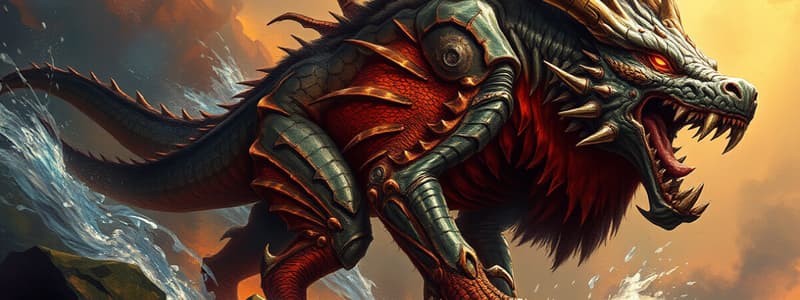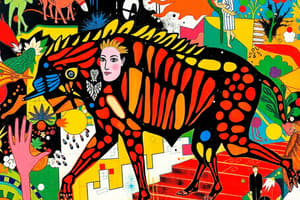Podcast
Questions and Answers
What do fossils represent in the context of biological history?
What do fossils represent in the context of biological history?
- Invertebrate structures from marine environments
- Artifacts from ancient human civilizations
- Remnants of past life preserved in the earth (correct)
- Modern organisms and their habitats
Which concept refers to the gradual evolution of one species into a new species?
Which concept refers to the gradual evolution of one species into a new species?
- Phyletic Speciation (correct)
- Divergent Speciation
- Sympatric Speciation
- Allopatric Speciation
Which type of speciation occurs when populations are separated by geographic barriers?
Which type of speciation occurs when populations are separated by geographic barriers?
- Divergent Speciation
- Allopatric Speciation (correct)
- Sympatric Speciation
- Phyletic Speciation
What is the primary purpose of adaptation in evolution?
What is the primary purpose of adaptation in evolution?
Which of the following is NOT a criterion for defining a species?
Which of the following is NOT a criterion for defining a species?
How does habitat influence evolution?
How does habitat influence evolution?
What type of speciation occurs within a single geographic area, often leading to specialization?
What type of speciation occurs within a single geographic area, often leading to specialization?
What signifies a phyletic line in evolutionary biology?
What signifies a phyletic line in evolutionary biology?
Which of the following best represents Darwin's idea of common descent?
Which of the following best represents Darwin's idea of common descent?
Which of the following represents a gradual evolutionary change?
Which of the following represents a gradual evolutionary change?
What distinguishes divergent speciation from other forms of speciation?
What distinguishes divergent speciation from other forms of speciation?
Which of the following features may indicate speciation has occurred?
Which of the following features may indicate speciation has occurred?
What does convergence in evolution imply?
What does convergence in evolution imply?
What is a key concept of Darwinian evolutionary theory?
What is a key concept of Darwinian evolutionary theory?
Which of the following is true about perpetual change?
Which of the following is true about perpetual change?
What occurs in divergence during the evolutionary process?
What occurs in divergence during the evolutionary process?
What structure in mammals develops into the embryo during gastrulation?
What structure in mammals develops into the embryo during gastrulation?
What structure in chordates is derived from mesoderm and serves as a point for muscle attachment?
What structure in chordates is derived from mesoderm and serves as a point for muscle attachment?
What does the bilaminar disc consist of in early embryonic development?
What does the bilaminar disc consist of in early embryonic development?
Which of the following is NOT a distinctive characteristic of chordates?
Which of the following is NOT a distinctive characteristic of chordates?
During which process does the bilaminar disc convert into a trilaminar disc?
During which process does the bilaminar disc convert into a trilaminar disc?
How does the dorsal tubular nerve cord in chordates differ from that of hemichordates?
How does the dorsal tubular nerve cord in chordates differ from that of hemichordates?
Which structure is formed from the epiblast during gastrulation?
Which structure is formed from the epiblast during gastrulation?
What do hemichordates share with echinoderms?
What do hemichordates share with echinoderms?
What is the function of the notochordal plate during early embryonic development?
What is the function of the notochordal plate during early embryonic development?
During which stage are the five distinctive characteristics of chordates found?
During which stage are the five distinctive characteristics of chordates found?
Which of the following statements about deuterostomes is accurate?
Which of the following statements about deuterostomes is accurate?
Which characteristic is used to distinguish chordates from other animals?
Which characteristic is used to distinguish chordates from other animals?
What occurs to the notochord in vertebrates during development?
What occurs to the notochord in vertebrates during development?
What are the two layers that make up the blastoderm in chick gastrulation?
What are the two layers that make up the blastoderm in chick gastrulation?
Which structure is equivalent to the dorsal lip of the amphibian blastopore in chick gastrulation?
Which structure is equivalent to the dorsal lip of the amphibian blastopore in chick gastrulation?
During chick gastrulation, what do the cells moving anteriorly and ventrally from the epiblast form?
During chick gastrulation, what do the cells moving anteriorly and ventrally from the epiblast form?
What happens to the hypoblast cells during chick gastrulation?
What happens to the hypoblast cells during chick gastrulation?
What is the fate of the ectoderm in chick gastrulation?
What is the fate of the ectoderm in chick gastrulation?
What is the role of the primitive streak in chick gastrulation?
What is the role of the primitive streak in chick gastrulation?
Where does the anal region form during chick gastrulation?
Where does the anal region form during chick gastrulation?
What is notable about the formation of the gut during chick gastrulation?
What is notable about the formation of the gut during chick gastrulation?
Flashcards are hidden until you start studying
Study Notes
Adaptation and Evolution
- Adaptation involves structural modifications to enhance survival in specific environments.
- It is a hereditary change in phenotype driven by environmental pressures and natural selection, promoting advantageous genetic mutations.
- Habitat acts as a selection pressure, influencing evolutionary processes and genetic inheritance in organisms.
- The relationship between evolving organisms and changing environments results in evolutionary dynamics.
Phyletic Line and Extinction
- A phyletic line is a continuous lineage documented in the fossil record, showcasing linear and branching evolution.
- Extinction occurs when species fail to adapt to rapid environmental changes, often affecting entire groups of organisms.
Evolutionary Trends/Morphocline
- Evolutionary trends refer to gradual adaptive changes in features within a phyletic line, typically seen in large populations.
- The evolution of modern horses from the Eocene epoch (57.8 million years ago) illustrates significant trends:
- Increasing body size.
- Reduction of toe numbers.
- Enlargement of tooth grinding surfaces.
- George Gaylord Simpson established that these trends align with Darwinian evolutionary theory.
Parallelism and Convergence
- Parallel evolution involves the independent evolution of similar traits from a shared ancestral condition.
- Convergence describes the evolution of similar traits in different lineages, resulting in analogous features.
- Divergence refers to a population developing into a new species over time.
Darwinian Evolutionary Theory
- Key principles include:
- Perpetual Change: Constant alteration in life's form and diversity evident in the fossil record.
- Common Descent: All organisms originate from a single ancestral form depicted as a branching phylogenetic tree.
- Multiplication of Species: The process by which new species emerge.
- Gradualism: Evolution happens gradually over time.
- Natural Selection: Mechanism driving evolution by favoring advantageous traits.
Fossils and Evidence
- Fossils can be complete remains, petrified parts, or trace fossils (impressions, trackways).
- The stratigraphic record reveals evolutionary relationships among species through horn size and shapes over geological ages.
Species Definition and Speciation
- Defining species is complex. Criteria include common descent and reproductive community exclusivity.
- Speciation involves two processes:
- Phyletic Speciation: Gradual transformation of one species into another.
- Divergent Speciation: Populations diversify into new species while some retain original traits.
Types of Speciation
- Allopatric Speciation: Occurs when populations are geographically separated, leading to reproductive barriers over time.
- Sympatric Speciation: Occurs within a shared geographic area where differentiation happens due to specialization.
Phylum Hemichordata
- Hemichordates are deuterostomes displaying radial cleavage and coelom development.
- Their larvae share similarities with echinoderms, and they have features like gill slits and a dorsal nerve cord.
Phylum Chordata
- Chordates, dating back to the Cambrian period, are bilaterian animals part of Deuterostomia, sharing a close relation with urochordates and cephalochordates.
- Distinguishing features include:
- Notochord: Flexible rod from mesoderm, early endoskeleton structure.
- Dorsal Tubular Nerve Cord: Dorsally located nerve cord that forms the brain.
- Pharyngeal Pouches: Gill slits present in the embryonic stage.
- Endostyle: A secretion involved in feeding.
- Postanal Tail: Present in all chordates at some development stage.
Gastrulation in Chick and Mouse
- Gastrulation results in the formation of germ layers, with notable differences between species:
- Chick gastrulation progresses through a primitive streak and involves epiblast and hypoblast layers leading to the germ layers.
- Mouse development produces a blastocyst with an inner cell mass becoming the embryo while the trophoblast forms placenta.
- The notochordal process and three germ layers (ectoderm, endoderm, mesoderm) arise during these processes.
Studying That Suits You
Use AI to generate personalized quizzes and flashcards to suit your learning preferences.




